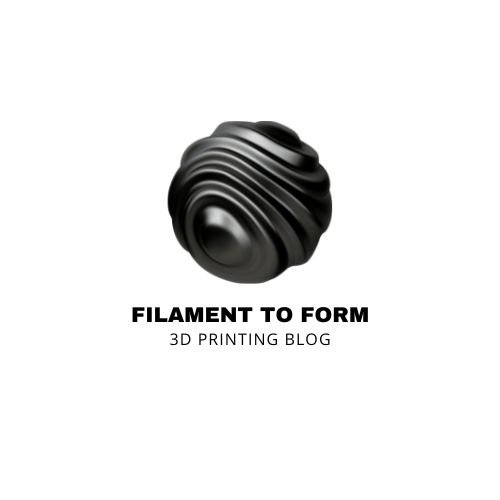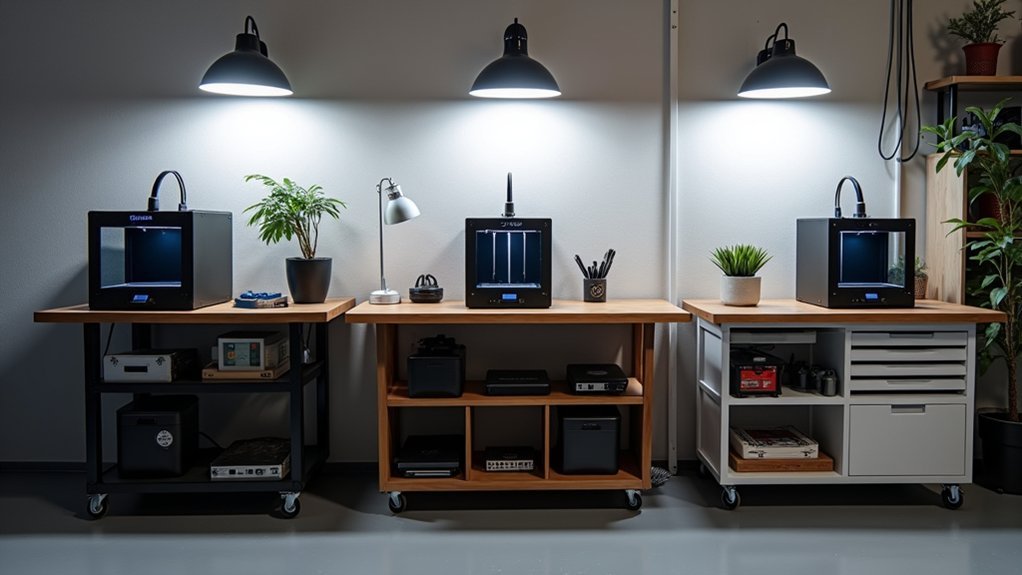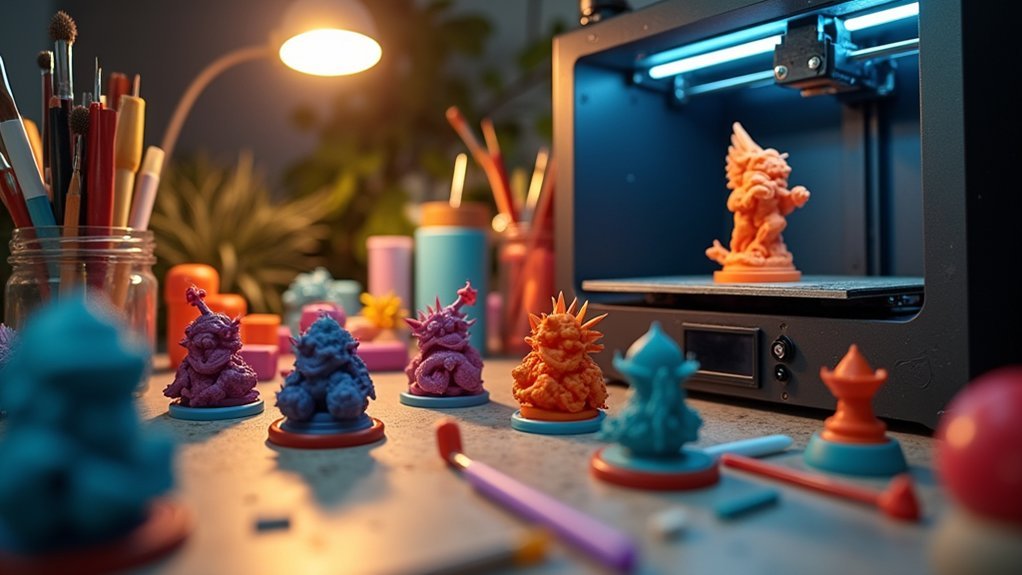You’ve invested in a quality 3D printer, but you’re quickly realizing that your current workspace isn’t cutting it. Vibrations affect print quality, there’s nowhere to store filaments and tools, and you’re constantly rearranging your desk to accommodate projects. The right table or workstation transforms your entire printing experience, providing the stability and organization your creative work demands. Three standout options offer distinct advantages that’ll address your specific setup challenges.
3D Heavy Duty Printer Stand with Storage and Wheels
The 3D Heavy Duty Printer Stand with Storage and Wheels transforms your workspace if you’re dealing with limited office real estate and need both a stable printing platform and organized storage. This steel-constructed stand measures 23.62 x 23.62 x 23.62 inches and weighs 32.2 pounds, offering durability that wooden alternatives can’t match. You’ll appreciate the lockable cabinet doors that provide security and dust protection for your supplies. Four rotating wheels with braking systems let you reposition the stand easily while maintaining stability during operation. The modern design works in both home offices and professional environments. With a 3.9-star rating, it’s a functional workspace solution.
Best For: Office workers and home users who need a mobile, secure storage solution for their printer and office supplies in spaces where flexibility and organization are priorities.
Pros:
- Steel construction offers superior durability compared to wooden alternatives and includes lockable doors for security and dust protection
- Four rotating wheels with braking system provide excellent mobility while maintaining stability during operation
- Combines printer platform and storage cabinet functionality in a space-efficient design that works in both home and professional environments
Cons:
- Mixed customer reviews indicate concerns about thin metal construction and overall stability during use
- Assembly process can be challenging with reported issues regarding screws and alignment difficulties
- Moderate 3.9-star rating suggests inconsistent quality and construction issues that may affect long-term satisfaction
25.6 x 23.6 Extra Large Rolling Printer Stand Table with Adjustable Storage Shelf
The reinforced steel tube frame supports 100 pounds per tier, ensuring your equipment stays secure during operation. Premium particle board resists water and wear, protecting your investment from workshop conditions. Industrial-grade lockable wheels let you reposition your setup effortlessly, while adjustable foot pads eliminate wobbling on uneven floors.
Assembly’s straightforward with numbered parts and included tools, getting you printing faster.
Best For: Home office users, small businesses, and hobbyists who need a sturdy, mobile workstation for heavy equipment like 3D printers, large printers, or scanners with flexible storage requirements.
Pros:
- Exceptional weight capacity of 100 lbs per tier with reinforced steel tube frame construction for maximum stability
- Five adjustable height levels on middle shelf (10.9″ to 18.7″) accommodate various equipment sizes and storage needs
- Industrial-grade lockable wheels and adjustable foot pads provide both mobility and stability on any surface
Cons:
- Heavy 47.8-pound weight makes it difficult to move when fully loaded despite having wheels
- Some customers report color discrepancies between advertised product images and actual received item
- Large 25.6″ x 23.6″ footprint may not fit in smaller office spaces or cramped work areas
FLASHFORGE Adventurer 5M 3D Printer, High-Speed Auto Leveling
High-speed printing capabilities and full-auto leveling make the FLASHFORGE Adventurer 5M an exceptional choice for makers who demand both efficiency and precision in their 3D printing workflow. You’ll achieve maximum speeds of 600mm/s with 20,000mm/s² acceleration, getting from unboxing to printing in just 10 minutes. The one-click auto leveling guarantees perfect first layers every time, while vibration compensation eliminates ghosting for smooth, professional results. You’ll appreciate the filament run-out sensor and power loss recovery features that prevent failed prints. The flexible removable PEI steel plate supports multiple materials including PLA, PETG, TPU, and carbon fiber variants.
Best For: Makers and hobbyists who prioritize speed and efficiency in their 3D printing workflow while needing reliable auto-leveling and multi-material compatibility.
Pros:
- Exceptional speed capabilities with 600mm/s printing and 20,000mm/s² acceleration for rapid project completion
- One-click auto leveling ensures perfect first layers and eliminates manual bed calibration hassles
- Smart features like filament run-out sensor and power loss recovery prevent failed prints and material waste
Cons:
- Open design requires well-ventilated environments, limiting placement options in confined spaces
- Limited nozzle temperature of 280°C may restrict compatibility with high-temperature engineering materials
- Print volume of 220x220x220mm may be insufficient for larger projects or prototypes
Factors to Consider When Choosing 3D Printer Tables and Workstations
When you’re selecting a 3D printer table or workstation, you’ll need to evaluate several critical factors that directly impact your printing experience and workspace efficiency. Your choice should account for weight capacity requirements, available storage and organization features, and whether you need mobility or prioritize stability. You’ll also want to take into account the assembly process, construction quality, and verify the size matches your printer’s dimensions and room constraints.
Weight Capacity Requirements
Stability forms the foundation of any successful 3D printing setup, making weight capacity one of the most critical factors you’ll evaluate when selecting a table or workstation. You’ll need to guarantee the table’s weight capacity meets or exceeds your printer’s weight plus any additional equipment. Some tables support up to 100 lbs per tier, but don’t forget about weight distribution—uneven placement can cause instability and damage.
Look for reinforced frames or steel tubing construction, which enhance weight-bearing capacity and durability. You should also plan for future upgrades or accessories that might add weight to your setup. Heavy-duty tables provide superior stability and longevity, making them the smarter investment for substantial 3D printers and related equipment.
Storage and Organization
Effective storage and organization capabilities can make or break your 3D printing workflow, transforming a cluttered workspace into an efficient production environment. You’ll want multiple tiers or shelves that provide ample storage space for organizing equipment, tools, and materials while ensuring easy access and maintaining tidiness.
Look for adjustable shelves that accommodate items of different sizes, enhancing your workstation’s versatility. This flexibility allows you to store both large printers and smaller office supplies effectively. Lockable cabinets offer significant benefits by securing important documents and materials while providing protection against dust and unauthorized access.
High-quality materials like reinforced steel tubes and durable particle board contribute to overall sturdiness, essential for supporting heavy printers and supplies while maintaining organizational integrity throughout your creative projects.
Mobility and Stability
Beyond organizing your workspace efficiently, you’ll need furniture that moves when you want it to and stays rock-solid when you don’t. Look for tables equipped with lockable wheels that provide smooth mobility while securing your workstation during printing operations. Industrial-grade wheels guarantee effortless repositioning without sacrificing durability.
Adjustable foot pads are essential for compensating uneven floors and eliminating wobbling that could compromise print quality. Check the weight capacity of shelves to confirm they’ll support your heavy equipment without flexing or sagging.
Steel frame construction offers superior stability compared to lighter materials, creating a solid foundation for precise printing. This robust design maintains rigidity even when fully loaded with printers, filaments, and tools while still allowing easy movement when needed.
Assembly and Construction
Three key factors determine whether your 3D printer table assembly becomes a smooth weekend project or a frustrating ordeal. First, check if parts come clearly numbered with included tools—this dramatically reduces setup time and eliminates guesswork. Second, consider the construction material’s impact on your assembly experience. While metal frames typically offer superior durability compared to wooden cabinets, you’ll want to make certain the metal isn’t too thin, as this can create stability concerns during use.
Third, read user feedback about assembly experiences before purchasing. Reviews reveal whether a product’s truly user-friendly or requires additional support during setup. Look for tables with adjustable features like multiple shelf height settings, which enhance functionality while accommodating various equipment sizes for your creative workspace.
Size and Compatibility
When choosing your 3D printer table, you’ll need to match the workstation’s dimensions precisely to your printer’s footprint and operational requirements. For example, the FLASHFORGE Adventurer 5M requires adequate space for its 220x220x220mm print size plus clearance for operation. You’ll want to verify the table’s weight capacity matches your equipment—look for workstations supporting at least 100 lbs per tier to handle heavier printers and scanners safely.
Consider adjustable height features that let you customize the setup based on your printer’s specific dimensions and your comfort level. Don’t forget about storage needs; multiple tiers provide vital organization space for tools and materials. Finally, confirm the workstation’s design promotes proper ventilation, which is essential for different printing materials.
Frequently Asked Questions
How Much Weight Can Most 3D Printer Tables Safely Support?
Most 3D printer tables you’ll find can safely support between 50-200 pounds. You’ll want to check manufacturer specifications since weight capacity varies considerably based on materials, construction quality, and design features.
What’s the Ideal Height for a 3D Printer Workstation?
You’ll want your 3D printer workstation at standing desk height, around 28-30 inches. This lets you easily monitor prints, perform maintenance, and access filament without constantly bending down or straining your back.
Do I Need Ventilation Considerations When Choosing a Printer Table Location?
You’ll definitely need ventilation when positioning your printer table. Many filaments release fumes during printing, so place your workstation near windows, exhaust fans, or well-ventilated areas to maintain healthy air quality.
Can These Tables Accommodate Multiple 3D Printers at Once?
You can find tables designed for multiple printers, but you’ll need to check weight capacity and dimensions. Larger workstations often accommodate two to four printers, depending on each printer’s size and weight.
What Tools Are Typically Required for Assembling 3D Printer Workstations?
You’ll typically need a Phillips head screwdriver, Allen wrenches (usually included), and possibly a rubber mallet. Most workstations come with pre-drilled holes and detailed instructions, making assembly straightforward with basic tools.





Leave a Reply